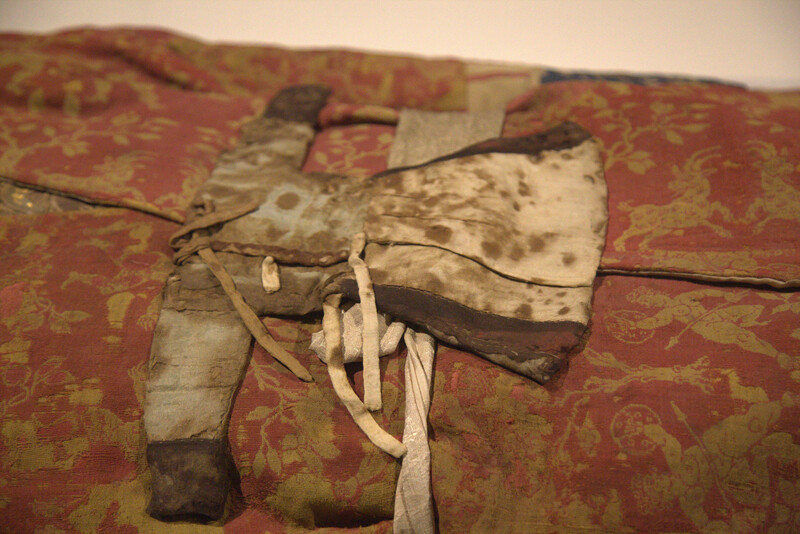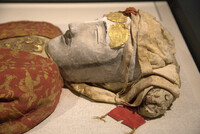Yingpan Man
Type:
Skeletons and mummies,
Textiles,
Wood
Date:
Third to early fifth century
Location or Findspot (Modern-Day Country):
China
Description:
This male Caucasian in his early 30s, almost 2 meters tall, was discovered in 1995 in tomb 15 at Yingpan, at the edge of the Taklamakan Desert. He was buried in a wooden coffin painted with flowers and covered with a carpet. The naturally mummified body has mostly decomposed, but the death mask and garments were well preserved in the desert air. These garments, which can be dated between the third and fifth centuries, exemplify the trade in textiles along the Silk Routes in the late antique period.
The man's mask and felt boots are ornamented with gold. His head rests on a silk pillow, and his undergarment is also silk. Over embroidered wool pants he wears a red and gold wool caftan, double-woven (i.e., two complete layers) with images of nude Greco-Roman putti, goats, and wreathed sacrificial bulls. The caftan has crossed lapels but is closed on the right side in accord with Chinese fashions. A miniature white caftan was placed on the man's chest. The caftan cloth may have been woven by artists in the eastern part of the Roman Empire and then traded farther east, or it may have been produced locally to imitate Roman and Iranian examples. The dyes are all derived from plants and most were available locally, but the yellow had to be imported from western Asia.
The unknown man may have been a Sogdian merchant; Sogdians controlled the Central Asian trade routes in this period. Buried alongside a square of silk with the Chinese word for "longevity" and a Sasanian glass bowl, the man must have traded widely. He is now in the Xinjiang Regional Museum at Urumqi, China.
The man's mask and felt boots are ornamented with gold. His head rests on a silk pillow, and his undergarment is also silk. Over embroidered wool pants he wears a red and gold wool caftan, double-woven (i.e., two complete layers) with images of nude Greco-Roman putti, goats, and wreathed sacrificial bulls. The caftan has crossed lapels but is closed on the right side in accord with Chinese fashions. A miniature white caftan was placed on the man's chest. The caftan cloth may have been woven by artists in the eastern part of the Roman Empire and then traded farther east, or it may have been produced locally to imitate Roman and Iranian examples. The dyes are all derived from plants and most were available locally, but the yellow had to be imported from western Asia.
The unknown man may have been a Sogdian merchant; Sogdians controlled the Central Asian trade routes in this period. Buried alongside a square of silk with the Chinese word for "longevity" and a Sasanian glass bowl, the man must have traded widely. He is now in the Xinjiang Regional Museum at Urumqi, China.
Relevant Textbook Chapter(s):
2
Repository and Online Resources:
• Learn more with the Penn Museum's online exhibition "Secrets of the Silk Road."
Image Credits:
Linda Safran




